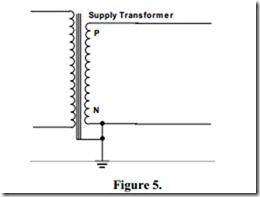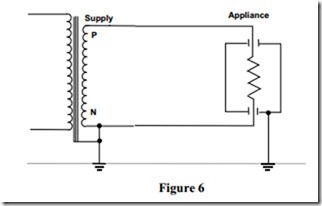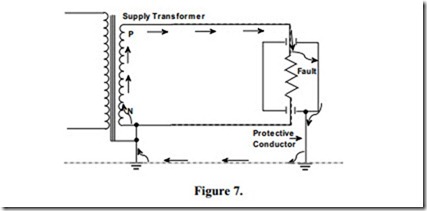Earthing
The following is an introduction to earthing, the topic will be dealt with in more detail in the Course Notes for Unit 2.2.6. The general mass of earth is made up almost entirely of materials which are reasonable electrical conductors, or become so when moist.The general mass of the earth is considered to be at zero potential and is defined as follows: “The conductive mass of the earth, the electric potential of which at any point is conventionally taken as equal to zero.”
In practice, the neutral at the supply mains is almost always connected to the general mass of the earth. This is done by connecting a conductor from the neutral at the supply origin to earth. See Figure 5.
This means that a person touching a live part of an installation, whilst standing on the earth, would suffer a severe electric shock. Remember that the accepted lethal level of shock current passing through a person is only 50 mA. Similarly, an electric shock would occur if the person were touching a faulty appliance and an earthed metallic gas or water pipe.
One method of providing some measure of protection against these effects is to connect together ( bond ) all metallic parts of an installation and connect them to earth. See Figure 6. This ensures that all metalwork is at zero potential. As a result under fault conditions this metalwork will remain at or near the same potential. Simultaneous contact with two such metal parts would not result in a shock being received.
When a phase to earth fault occurs on an appliance, a current can flow via the earthed metalwork, back to the supply neutral, as shown in Figure 7.
These currents are referred to as “earth leakage currents” or “earth fault currents”.
Earth Leakage Currents
Insulation is not perfect. Earth leakage current of perhaps no more than a few milliamps can flow through the insulation on items of electrical equipment, cables etc. These currents are “normal earth leakage currents”. They cause no problems; For example: 5 mA flowing through the insulation of an electric kettle element. If the insulation deteriorates this current will increase to an unacceptable level.
For example: 30 mA flowing through the insulation of an electric kettle element. Should this occur the supply must be disconnected from the item.
Leakage currents of approximately 300 mA are capable of starting a fire.
These currents can be detected and interrupted by Residual Current Devices ( RCD’s ).
Earth Fault Currents
A large current will flow to earth in the event of an earth fault. In this case a live conductor actually comes in contact with something that is connected to earth, For example: A protective conductor or the frame of an appliance.
Earth fault currents may be in the order of hundreds or even thousands of amps. Should a fault of this nature occur, the supply must be disconnected very very quickly. Otherwise persons or animals may be electrocuted and serious damage done to electrical equipment.
All earthing and bonding conductors and connections must be capable of carrying a sustained fault current without overheating. Danger often arises from the use of inadequate conductor sizes, inadequate connections, such as a poorly made earth connection, an earth clamp which has worked loose, or corrosion of parts of the earthing system.
Earth fault currents can be detected and interrupted by fuses, circuit breakers and residual current devices.


